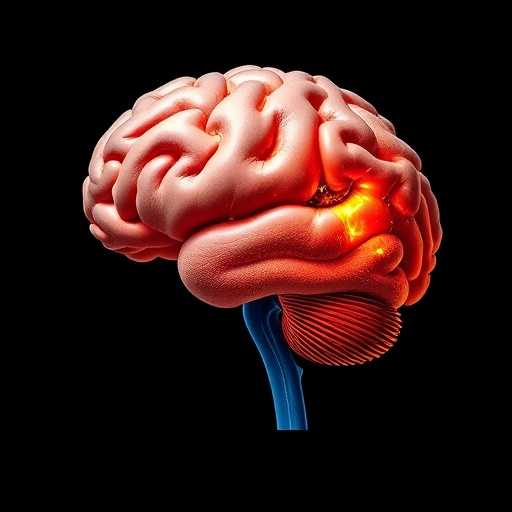In a groundbreaking longitudinal investigation into the emergence and persistence of psychotic-like experiences (PLEs) during early adolescence, researchers have illuminated the dynamic interplay between genetics, environmental stressors, cognitive decline, and brain morphology. This extensive study, leveraging the unique dataset of the Adolescent Brain Cognitive Development (ABCD) Study, offers compelling evidence that trajectories of cognitive and brain structural changes are not only associated with but may also mediate the relationship between early-life risks and enduring distressing PLEs. The findings have significant implications for early identification and intervention strategies aimed at mitigating the progression towards severe mental illness.
Psychotic-like experiences, which encompass subclinical symptoms such as hallucinations and delusional thoughts, have long been recognized as potential precursors to diagnosable psychiatric disorders like schizophrenia. However, not all youth who report PLEs go on to develop persistent symptoms or clinical diagnoses; many experience transient episodes that remit naturally. Understanding what distinguishes persistent distressing PLEs—episodes that are both enduring and cause significant distress—from transient or low-level experiences remains a critical challenge for researchers and clinicians alike.
The study at the forefront of this discourse employed sophisticated multigroup latent growth modeling to parse developmental trajectories among youth aged 9 to 13 years. By analyzing data across three waves, the research team categorized participants into three distinct groups: those enduring persistent distressing PLEs, those experiencing transient distressing episodes, and those reporting only low-level, non-distressing PLEs. This stratification allowed for nuanced examination of how cognition and brain morphometry evolve over time among these subgroups.
One of the study’s pivotal revelations is that youth with persistent distressing PLEs exhibited significantly greater declines in several cognitive domains over the study period compared to their peers with transient or low-level PLEs. These domains encompass working memory, processing speed, and executive functions, faculties critical for adaptive and goal-directed behavior. This decline in cognitive performance suggests a progressive neuropsychological deterioration coinciding with the persistence of distressing psychotic-like symptoms, underscoring the importance of longitudinal assessments in youth mental health research.
In parallel with cognitive trajectories, the investigation also documented pronounced changes in global brain morphometry metrics among individuals with persistent distressing PLEs. Morphometry, which refers to the measurement of brain structures including cortical thickness, surface area, and gray matter volume, provides vital indices of brain maturation and integrity. The observed steeper reductions in these morphometric markers in the persistent-distress group contrast sharply with the relatively stable trajectories in low-level PLE youth, hinting at an underlying neurodevelopmental vulnerability.
The results also echoed conceptual frameworks proposing that cumulative environmental risks—such as early life adversity, socioeconomic deprivation, and exposure to trauma—interact with genetic predispositions to influence neurodevelopment negatively. Importantly, the study’s analytic models demonstrated that the deteriorations in cognition and brain morphometry partially attenuated the associations between environmental risk factors and persistent distressing PLEs. This mediating role suggests that cognitive and neural declines are crucial mechanisms through which external stressors amplify psychotic-like symptom persistence.
These insights support etiological models that posit a cascade beginning with genetic and environmental adversities leading to progressive brain and cognitive abnormalities, which in turn fuel the persistence and worsening of PLEs. The longitudinal design uniquely permitted the disentangling of temporality, showing that worsening neurocognition and morphometric reductions are not merely correlates but potentially active contributors to symptom chronicity.
Another compelling aspect of the research was its use of a large, demographically diverse sample afforded by the ABCD Study. Such breadth enhances the generalizability of the findings across socioeconomic strata and cultural backgrounds, bolstering their relevance for public health initiatives. Moreover, the utilization of repeated measures over multiple years adds robustness to the observed patterns, mitigating concerns regarding transient fluctuations being mistaken for developmental trends.
The study’s findings invigorate discussions about early intervention frameworks tailored to neurodevelopmental profiles. Identifying youth at risk for persistent distressing PLEs through trajectories of cognitive decline and brain structural changes could catalyze preventive strategies focusing on cognitive remediation and environmental modulation. Interventions designed to bolster executive function or mitigate environmental adversities hold promise in altering the course of at-risk youth before the onset of overt psychotic disorders.
Furthermore, the research underscores the need to integrate neuroimaging markers into routine developmental assessments. While currently more common in research contexts, advancements in imaging technologies and analytic methods may soon render morphometric evaluations feasible in clinical settings. Such objective biomarkers, combined with genetic and psychosocial data, could afford a precision psychiatry approach to youth mental health.
Despite its strengths, the study acknowledges certain limitations that future work should address. For instance, while global morphometry provides valuable macrostructural insights, finer-scale regional analyses might reveal localized brain alterations more tightly linked to specific PLE symptomatology. Additionally, extending follow-up into later adolescence and early adulthood could clarify whether observed trajectories predict transition to clinical psychosis or other psychiatric outcomes.
Intriguingly, the data also invite exploration into potential resilience factors whose presence may buffer against cognitive and structural decline, thereby promoting symptom remission. Understanding what differentiates youth in the transient distressing PLE group from those with persistent symptoms could illuminate pathways to recovery and inform tailored therapeutic approaches.
In conclusion, this landmark study charts a sophisticated developmental map linking genetic and environmental risk factors to the persistence of distressing psychotic-like experiences through progressive cognitive and brain morphological changes. These findings not only enrich the conceptual landscape of early psychosis research but also lay foundational groundwork for translational efforts aimed at improving prognostic precision and preventative care in adolescent mental health. The emerging narrative portrays adolescence as a critical window wherein dynamic brain and cognitive changes interact with life experiences to shape psychiatric trajectories, offering a beacon of hope for timely, targeted intervention.
Subject of Research: Developmental trajectories of cognition and brain morphometry as predictors of persistent distressing psychotic-like experiences in youth
Article Title: Cognitive and global morphometry trajectories as predictors of persistent distressing psychotic-like experiences in youth
Article References:
Karcher, N.R., Dong, F., Paul, S.E. et al. Cognitive and global morphometry trajectories as predictors of persistent distressing psychotic-like experiences in youth. Nat. Mental Health (2025). https://doi.org/10.1038/s44220-025-00481-9
Image Credits: AI Generated




